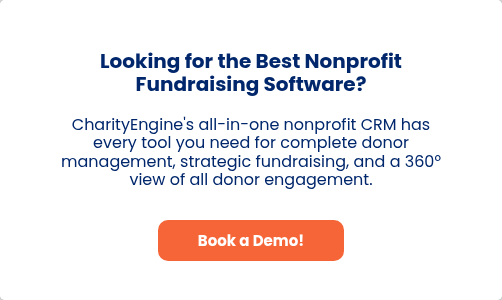
“Direct mail is so yesterday.” When considering how to reach your nonprofit fundraising goals, has this thought crossed your mind?
You wouldn’t be the first to quickly discount the good old USPS. Think about it: is it worth the costs of printing and stamps, just to have your letter tossed in the trash with the rest of the junk mail?
It sure is. Direct mail response rates hover between 5% and 9%. In contrast, email response rates are around 0.1%. That is a substantial difference that more than makes up for the cost of a stamp.
On average, a person receives more than 100 emails a day. But they receive an average of about two pieces of regular mail, and people hold on to mail a lot longer than they look at an email.
According to the United States Postal Service, 88% of millennials look through their physical mail. Across all age groups, physical ads are more effective at leaving a lasting impression than digital ads, and everyone spends more time on physical content than digital.
So it’s not looking like direct mail is a dinosaur.
Savvy nonprofits have a robust direct mail program and use it more often than any other outreach method. Because there is a cost involved—designing the piece, printing it, mailing it—there tends to be more strategy behind direct mail than email. It’s rare to find a typo on a mailed piece, and you never have to worry about broken links!
Why Does Direct Mail Work?
We said you wouldn’t be the first person to discount direct mail. In fact, you would have a lot of company. That means that direct mail isn’t as common an outreach method as others, and you won’t have a lot of competition. It’s certainly easier to have your direct mail piece stand out than your email.
Personalizing direct mail and creating a piece your donors will remember is easy. Get creative and use colors, fonts, and design elements to make sure your card or letter catches the eye of the recipient.
Think about how quickly you delete emails that you view as spam. Then picture yourself walking to your mailbox and flipping through your mail. At the very least, you’ll glance at the contents of the mail before designating it as trash.
Because it’s considered to be slightly more old school, direct mail is also considered to be more trustworthy. This makes it an effective outreach tool for smaller nonprofits that might not yet be household names.
How to Create a Great Piece of Direct Mail
If you have a fantastic logo, this is a prime place to showcase it! If you have the most boring logo on the planet, redesign it—or just use color on the rest of the card or letter. But don’t make it so busy that it’s hard to know where to look.
Personalize your mail and reference previous engagements. This can be, “Hi, Dave, and thanks for your recent gift of $10. You helped clean up the park down the street!” It could also be, “Hello, Caroline, and thank you so much for volunteering to pick up trash at the park last weekend.” Let your donors know they’re seen and appreciated.
Have a clear call to action. Our mantra is that nonprofits have to make it easy to give, and direct mail must adhere to that as well. The best direct mail pieces (touch #1) send people to your website (touch #2) and a donation form (touch #3). Use a QR code on your card or come up with a memorable URL for your donation page.
Include something of value. It can be a bookmark, a magnet, or even a code they can enter on your website (two touches!) if they want a t-shirt. You might often see branded calendars sent to donors in December; people usually keep these for several months, if not a year. You can also promise that donors who give a certain amount will be mailed a gift and have something branded for this purpose. It can be pens, pads, water bottles, or almost anything you could mail inexpensively.
Consider making it a regular communication. What about a quarterly newsletter through which you share your successes and spotlight important facts about your nonprofit’s impact? You can use photos and case studies of donations and volunteer acts that make a difference. If you have a good nonprofit CRM, you’ll know special dates like birthdays or anniversaries. These could be commemorated with a card.
Using Nonprofit Direct Mail in a Multichannel Campaign
Multichannel fundraising approaches, or campaigns that utilize different media channels to reach donors, are more likely to lead to fundraising success because they allow you to spread your net as wide as possible. Different channels naturally have different target audiences, so when you use these different channels strategically, you can set your organization up to expand your reach.
Here are some top tips to help you get the most out of your campaign.
1. Maintain consistent branding throughout different channels
With a combined direct mail and online fundraising campaign, you’ll likely be utilizing several channels to reach your supporters. In addition to your direct mail appeals, different online channels you may use include:
- Social media
- Text
- Online
With so many venues for interacting with your supporters to garner donations, it’s vital that your nonprofit maintain consistent branding throughout.
The Visuals
The look and feel of your nonprofit’s public-facing platforms should be easily recognized as belonging to your organization. Making sure your branding is consistent will:
- Reduce confusion. When you’re using multiple channels to fundraise, the last thing you want is for donors to be confused. An identical logo, font type, and similar colors across all of your communications will make sure your donors always know where they are and who you are. You may even consider including these elements on the outside of your direct mail envelopes so donors know who the mail is from from the get-go.
- Increase trust. Brands with a consistent identity across channels are more likely to be trusted by donors than those without one.
- Increase cohesion. Because visual cues are rapidly taken in and understood, the more consistent your branding is the more likely your multiple touchpoints are to be recognized as being from the same organization and campaign.
- Increase awareness. With your logo and colors firmly attached to your organization and its mission, you can spread awareness easily with just the visual aspect of your brand, allowing for rapid recognition and association with your cause.
To help facilitate brand recognition and cohesion, it may be helpful for your organization to design a branding guide that clearly outlines the main aspects of your brand, including your approved colors and typography guidelines. That way, your entire organization will have access to the defined brand identity, meaning you’ll never end up with incorrectly branded materials.
The Language
While the visual aspect of branding is an important component of your fundraising success, it’s also important to keep the same brand messaging across all of your channels.
“Messaging” refers to the content and tone of the copy that appears on these channels. Aspects of your messaging strategy include your mission statement, vision statement, and the case for support you present on all of your platforms.
Across every platform, the essential elements of these should be the same, especially within the same fundraising campaign. Keeping your messaging consistent makes sure your donors have a clear understanding of your cause, the need, and the reasons why they should donate.
Still, that doesn’t mean you should copy and paste the exact words from each channel onto the next. In fact, you should alter your copy depending on the channel. For example, text message appeals will be much shorter and more casual than your direct mail fundraising letters, and your Facebook posts shouldn’t just be an exact replica of your fundraising emails. Appropriately adjust your copy to fit the channel and its audience, but keep the essentials the same to maximize your campaign’s impact.
2. Drive traffic to your online donation page
While direct mail is an effective way to fundraise on its own, one way you can maximize your donations is to drive traffic from your direct mail audience to your organization’s online donation page. After all, many donors who open your direct mail appeals will prefer to respond with an online donation, especially as checkbooks and cash become less frequently used.
Including CTAs (or calls to action) directing users to your online fundraising efforts makes sure you capture the attention of the direct mail audience and offer them an alternative way to give. This way, you can maximize the donations you garner from direct mail appeals.
For example, consider including the following in your mailing:
- A text-to-give number and keyword. Because smartphones are so prevalent these days, odds are many of your donors will be close to their phones when they receive your fundraising letters. Take advantage of the convenience of texting by promoting your text-to-give number and keyword in your fundraising letters.
- Online donation form URL. Include the URL for your organization’s online donation page in your letters. Make sure it’s not too long or complicated, which would dissuade your audience from going to the effort to type it in. (Tip: don’t include links to your general website or social media pages. You don’t want potential donors getting distracted by your organization’s other content and forgetting to donate!)
- QR code. A scannable QR code that takes donors to your online donation form is an innovative way to harness smartphone technology to minimize the time it takes to donate. Without having to type in your URL manually, accessing your online donation form will be more convenient for your donors.
Because you’ll be driving donors to your online donation page, it’s wise to make sure your donation page is first optimally designed to maximize conversions. For example, you’ll want to prioritize simplicity, clarity, and ease of use. Keep required fields to a minimum so it will be more convenient for donors to complete the form. Remember, you can always find out more about your supporters after they’ve donated!
Finally, to further integrate your direct mail and online efforts, include a space on your physical donation form for mail-in givers to write their email addresses. That way, you can make sure your direct mail audience is also accessible via online means, maximizing the touchpoints each donor will receive for future campaigns.
3. Collect and analyze offline and online giving data
Along with every fundraising campaign come many useful data points you’ll want to store, track, and analyze to draw insights about the efficacy of your fundraising efforts. Doing so can help you understand where your organization’s fundraising strengths and weaknesses are and inform your future campaigns.
Tracking your fundraiser’s data can not only tell you how the fundraiser performed overall, but it can also provide more granular details about your donors’ habits that can help you assess (and improve) your direct mail and online fundraising efforts. For example, for donors who receive a direct mail appeal, you’ll want to know how donors are driven to give: which donors use reply envelopes, access your website’s URL to donate, or scan your QR code?
To determine this information, try a couple of different methods:
- Record traffic originating from your QR code
- Include an optional field on your online donation form for donors to enter the communication type they received that encouraged them to donate
Tracking these details allows you to hone your appeals to best target your donors. Then, tracking the response rate of your direct mail channel as a whole can help you decide how to allocate funds in your multi-channel approach next time.
Regardless of exactly which figures you want to track in your multi-channel campaign, you’ll likely need the assistance of nonprofit database software. A donor database allows you to store the information from your campaigns and automatically track information, analyze data, and report essential metrics regarding your campaigns. A good CRM allows your nonprofit to become more efficient, data-driven, and successful at furthering your cause. Our guide to donor management software can give you some more details on what to look for in a CRM system.
Direct Mail is Dynamite
Direct mail is the workhorse of a successful nonprofit. It’s personal, memorable, and offers impressive response rates.
And the more harried our lives become, the more enticing it is to slow down, open a mailbox, and page through the mail. More than 40% of Americans say they enjoy checking their mail every day, which leaves nonprofits with a happy and receptive audience!
When you pair direct mail with your CRM, you have insights into your donors, and it will be easier to personalize your outreach.
The next time you’re planning a fundraising campaign or thinking about your fundraising strategy, give direct mail a chance. You might be surprised at your success!




.png)
.png)